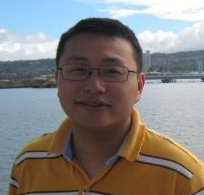报告时间:2016年6月17日下午14:30
报告地点:科技创新大楼C501室
报告题目:Small and Bright: Illuminating Life with Functional Luminescent Nanoparticles

Biogaphy
Dr. Gang Han is currently an Associate Professor in the Biochemistry and Molecular Pharmacology Department at University of Massachusetts- Medical School. He received his B.Sc. and M.S. degrees in Chemistry from Nanjing University, and his Ph.D. degree in Chemistry from University of Massachusetts-Amherst. He was a postdoctoral scholar at the Molecular Foundry, Lawrence Berkeley National Lab. He has published over 50 papers which have cited over 5600 times. He has been focusing on developing versatile luminesence nanoparticles (e.g., upconversion nanoparticles and persistent luminesence nanoparticles) for bioimaging and therapy. He was honored a Worcester Foundation Mel Cutler Award, a UMASS CVIP Technology Development Fund award, UMASS Clinical and Translational Science Award , a NIH Eureka Award and a Human Frontier Science Program Young Investigator Award, and an Alex's Lemonade Stand Foundation innovation award.
Small and Bright: Illuminating Life with Functional Luminescent Nanoparticles
Gang Han1, *
1University of Massachusetts-Medical School
364 Plantation Street, LRB 806, Worcester, MA USA
*Corresponding author:gang.han@umassmed.edu
Functional luminescent nanoparticles are promising materials for in vitro and in vivo optical imaging and therapy due to their unique optical and chemical properties. In this talk, I will present two new types of biocompatible luminescence nanoparticles. The first type of materials is upconversion nanoparticles (UCNPs). They absorb low energy near-infrared (NIR) light and emit high-energy shorter wavelength photons.1Their special features allow them to overcome various problems associated with conventional imaging probe at both single molecule and ensemble levels. I will present new developments regarding engineering UCNPs towards deep tissue imaging, photodynamic therapy, optogenetic applications in neuroscience2and immunotherapy.3The second type of nanoparticles is persistent luminescence nanoparticles (PLNPs). They are bioluminescence-like and possess unprecedented in vivo deep tissue energy rechargeability, outstanding signal-to-noise-ratio with no need for an excitation resource (light) during imaging, and they can be directly detected with existing imaging systems.4These nanoparticles continue to emit light for minutes or hours and, in some cases, days, after turning off the excitation source. These long-lasting, light-emitting nanocrystals can provide noninvasive imaging technology for evaluating structural and functional biological processes in living animals and patients. In addition, I would like also to introduce a nanobug concept towards cancer treatment.5
References
(1) Shen, J.; Zhao, L.; Han, G., Lanthanide-doped upconverting luminescent nanoparticle platforms for optical imaging-guided drug delivery and therapy. Adv Drug Deliver Rev 2013, 65 (5), 744-755.
(2) Wu, X.; Zhang, Y. W.; Takle, K.; Bilsel, O.; Li, Z. J.; Lee, H.; Zhang, Z. J.; Li, D. S.; Fan, W.; Duan, C. Y.; Chan, E. M.; Lois, C.; Xiang, Y.; Han, G., Dye-Sensitized Core/Active Shell Upconversion Nanoparticles for Optogenetics and Bioimaging Applications. Acs Nano 2016, 10 (1), 1060-1066.
(3) He, L.; Zhang, Y. W.; Ma, G. L.; Tan, P.; Li, Z. J.; Zang, S. B.; Wu, X.; Jing, J.; Fang, S. H.; Zhou, L. J.; Wang, Y. J.; Huang, Y.; Hogan, P. G.; Han, G*.; Zhou, Y. B.*, Elife 2015, 4:e10024.
(4) Li, Z. J.; Zhang, Y. W.; Wu, X.; Huang, L.; Li, D. S.; Fan, W.; Han, G. J Am Chem Soc 2015, 137 (16), 5304-5307.
(5) Regino Mercado-Lubo, Yuanwei Zhang, Liang Zhao, Kyle Rossi, Xiang Wu, Yekui Zou, Antonio Castillo, Jack Leonard, Rita Bortell, Dale Greiner, Lenny Schultz, Gang Han*, and Beth A. McCormick* Salmonella Nanoparticle Mimic Overcomes Multidrug Resistance in Tumors. Nature Communications , In press, 2016.
